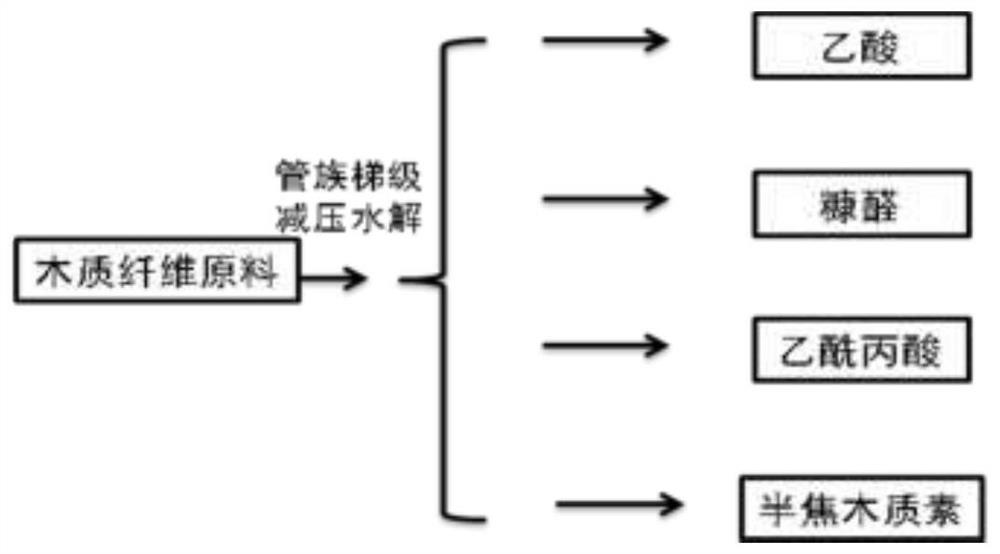Preparation method of bio-based polyalpha-olefin synthetic oil
An olefin synthetic oil, bio-based technology, used in the preparation of liquid hydrocarbon mixtures, biofuels, polymerization treatment, etc., can solve problems such as process pollution, achieve green process, improve safety factor and efficiency, and cheap and easy to obtain raw materials. Effect
- Summary
- Abstract
- Description
- Claims
- Application Information
AI Technical Summary
Problems solved by technology
Method used
Image
Examples
preparation example Construction
[0056] The preparation method of bio-based polyalpha-olefin synthetic oil specifically comprises the following steps:
[0057] Step 1: The lignocellulosic raw material is continuously hydrolyzed through the tube family cascade decompression to obtain lignin semi-coke (the percentage of ingredients: semi-coke content 88-92%, ash content 8-12%, calorific value 5500-6500 kcal);
[0058] Step 11: first-stage hydrolysis of lignocellulosic raw materials, converting hemicellulose in lignocellulosic raw materials into xylooligosaccharides;
[0059] The first stage of hydrolysis: the temperature is 200-240°C, the pressure is 2.2-2.4MPa, and the time is 0.5-5 minutes. The reaction converts the hemicellulose in the lignocellulosic raw material into xylooligosaccharides.
[0060] Step 12: the second hydrolysis of the lignocellulosic raw material, converting the cellulose in the lignocellulosic raw material into cellooligosaccharides;
[0061] The second stage of hydrolysis: the temperatu...
Embodiment 1
[0114] (1) 200kg corn stalks (moisture content 25%) are crushed to less than 1cm, and enter the tube family cascade decompression continuous hydrolysis reactor, including the first stage of hydrolysis: temperature is 205-210°C, pressure is 2.2-2.3MPa, time 3 Minutes, the hemicellulose in the straw is transformed into xylooligosaccharides and leached out; cellulose and lignin enter the second stage of hydrolysis: the temperature is 180-185 ° C, the pressure is 1.4-1.5 MPa, and the time is 20 minutes. The cellulose is converted into cellooligosaccharides and leached out; lignin enters the third stage of hydrolysis: 95%wt acetic acid catalyst, the temperature is 180-185°C, the pressure is 1.4-1.5MPa, and the time is 10 minutes, lignin is converted into wood Plain semi coke 114.2kg (water content 37-40%).
[0115] (2) Using 72kg of dry lignin semi-coke as raw material (water content 2-5%), using a space furnace gasification device, the output of the air separation device is 52000N...
Embodiment 2
[0128] (1) 200kg corn stalks (moisture content 25%) are crushed to less than 1cm, and enter the tube family cascade decompression continuous hydrolysis reactor, including the first stage of hydrolysis: temperature is 205-210°C, pressure is 2.2-2.3MPa, time 3 Minutes, the hemicellulose in the straw is transformed into xylooligosaccharides and leached out; cellulose and lignin enter the second stage of hydrolysis: the temperature is 180-185 ° C, the pressure is 1.4-1.5 MPa, and the time is 20 minutes. The cellulose is converted into cellooligosaccharides and leached out; lignin enters the third stage of hydrolysis: 95%wt acetic acid catalyst, the temperature is 180-185°C, the pressure is 1.4-1.5MPa, and the time is 10 minutes, lignin is converted into wood Plain semi coke 118.2kg (water content 37-40%).
[0129] (2) Using 74kg of dry lignin semi-coke as raw material (water content 2-5%), using a space furnace gasification device, the output of the air separation device is 52000N...
PUM
| Property | Measurement | Unit |
|---|---|---|
| viscosity index | aaaaa | aaaaa |
| viscosity index | aaaaa | aaaaa |
Abstract
Description
Claims
Application Information
 Login to View More
Login to View More - R&D
- Intellectual Property
- Life Sciences
- Materials
- Tech Scout
- Unparalleled Data Quality
- Higher Quality Content
- 60% Fewer Hallucinations
Browse by: Latest US Patents, China's latest patents, Technical Efficacy Thesaurus, Application Domain, Technology Topic, Popular Technical Reports.
© 2025 PatSnap. All rights reserved.Legal|Privacy policy|Modern Slavery Act Transparency Statement|Sitemap|About US| Contact US: help@patsnap.com



